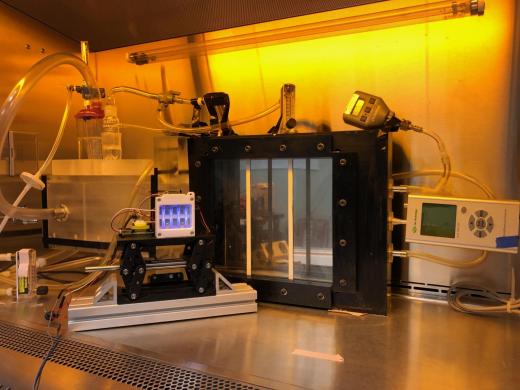Aiming to reduce the risk of COVID-19 infection and diminish coronavirus, UVC radiation has been widely promoted and applied in disinfection. But UVC radiation exposure could also lead to damage on skin and eye for human and animals. Finding a way to safely deploy UVC light has thus become a target for researchers all over the world.
Far-UVC with a wavelength of 222 nm is considered a safe alternative in UVC disinfection as many researchers found that the light can effectively deactivate germs and viruses without causing harm for people. A new study led by researchers of Columbia University proved that more than 99.9% of seasonal coronaviruses present in airborne droplets were killed when exposed to far-UVC light.
“Based on our results, continuous airborne disinfection with far-UVC light at the current regulatory limit could greatly reduce the level of airborne virus in indoor environments occupied by people,” says the study’s lead author David Brenner, PhD, Higgins Professor of Radiation Biophysics at Columbia University Vagelos College of Physicians and Surgeons and director of the Center for Radiological Research at Columbia University Irving Medical Center.
Previously, the team had shown that far-UVC light can safely kill airborne influenza viruses. The new paper extends their research to seasonal coronaviruses, which are structurally similar to the SARS-CoV-2 virus that causes COVID-19. The research was published in Scientific Reports.
In the study, the researchers used a misting device to aerosolize two common coronaviruses. The aerosols containing coronavirus were then flowed through the air in front of a far-UVC lamp. After exposure to far-UVC light, the researchers tested to see how many of the viruses were still alive.

(Image: Columbia University)
Based on their results, the researchers estimate that continuous exposure to far-UVC light at the current regulatory limit would kill 90% of airborne viruses in about 8 minutes, 95% in about 11 minutes, 99% in about 16 minutes, and 99.9% in about 25 minutes.
The researchers are also testing the efficacy of far-UVC light against airborne SARS-CoV-2. Preliminary data suggest that far-UVC light is just as effective at killing SARS-CoV-2.
“Far-UVC light doesn’t really discriminate between coronavirus types, so we expected that it would kill SARS-CoV-2 in just the same way,” Brenner says. “Since SARS-CoV-2 is largely spread via droplets and aerosols that are coughed and sneezed into the air, it’s important to have a tool that can safely inactivate the virus while it’s in the air, particularly while people are around.
By proving the effectiveness of far-UVC light on killing airborne coronavirus, researchers believe that it can be safe to apply disinfecting system based on far-UVC light in occupied indoor public places such as hospitals, buses, planes, trains, train stations, schools, restaurants, offices, theaters, gyms, and more, to reduce the risk of person-to-person transmission of coronaviruses, as well as other viruses such as influenza.





 CN
TW
EN
CN
TW
EN






